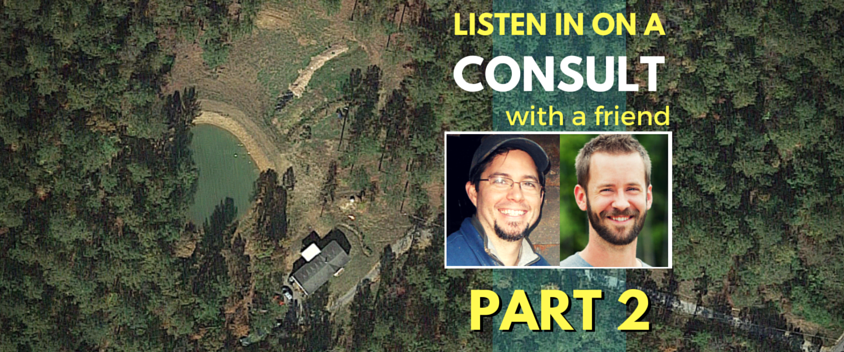E0029 | Listen in on a Consult with a Friend: Part 2
Podcast: Play in new window | Download
Subscribe: iTunes | Android | RSS
 Welcome back to another episode of the Homegrown Liberty Podcast. This is episode 29! Thank you for tuning in, this week Ken and I are continuing our conversation from last week, so if you haven’t listened to that episode you should go back right now and listen to it first to get a feel for who Ken is and get a little bit of the back story. We are trying a new thing out, I can’t promise it will be a regular occurrence, but if you guys like it, we’ll see how it goes and we might make these consulting calls a regular part of the show. But I need your feedback on what you like to hear! So please email me and give me your opinion, or let me know on Facebook. I do this for you guys to try and help you figure out how to live more self sufficient and self reliant.
Welcome back to another episode of the Homegrown Liberty Podcast. This is episode 29! Thank you for tuning in, this week Ken and I are continuing our conversation from last week, so if you haven’t listened to that episode you should go back right now and listen to it first to get a feel for who Ken is and get a little bit of the back story. We are trying a new thing out, I can’t promise it will be a regular occurrence, but if you guys like it, we’ll see how it goes and we might make these consulting calls a regular part of the show. But I need your feedback on what you like to hear! So please email me and give me your opinion, or let me know on Facebook. I do this for you guys to try and help you figure out how to live more self sufficient and self reliant.
Also, if you get on facebook and check out the recent posts. I had one on there about a homemade human powered baler. This thing is cool and probably something I’ll be building soon just to bale up cut fodder for my animals. It’s a hassle to cut the stuff and then haul it all in a wheel barrow back and forth over and over. It’d be much easier to bale it all up and be able to cart a couple bales at a time and save a bunch of trips! There’s only so many hours in the day and I don’t have all the time in the world so something simple like that can save me hours of work. You might want to check it out!
Before we get into the conversation, I wanted to just go over what we talked about briefly so you have an idea, and so if something is boring, you can skip it to get to something you want to listen to a little bit more. We start out talking about vine borers, go on to the McKibben’s pumpkin mania, we get into row covers, we talk about shade structures, how to use them and how valuable they are with side by side examples we have both observed in our years of growing. I talk about gardening vs. farming and how those two are only comparable in the way that they both require growing plants, but that’s about where the similarities end. Since they’re different, how to avoid some of the pitfalls of small scale row cropping which is what a lot of people try to do and have lots of problems because of it. Squash bugs, and a crazy solution to vegetables that don’t produce. You’ll think it’s insane but it really works!
So let’s start the show! What are we talking about next?
[INTERVIEW WITH NICK & KEN]
Yeah, that’s exactly right, pampering your plants can sometimes be a good thing, and sometimes it leads to reduced yields, so to all you listeners, remember to do things in moderation. Alright, that was part two of our interview, as you could hear, we had a lot of fun chatting and learning. I hope you had fun listening in to our conversation. Now I want to get into some of my closing thoughts and flesh out a little of what we talked about.
About those sweet potatoes, moisture and temperature aren’t the only considerations. I’m sure there was some other factor at play with those sweet potato vines that signalled it’s time to set tubers and build those carbohydrate reserves for the next growing season. I think they probably had a week of dry weather, or insect pressure, or disease pressure, there was likely something environmental, or it could have just been shortening of the days, or more specifically the change between the daylight to dark ratio that indicated the end of the growing season and pushed them to pull those resources out of the leaves and vines, to stop reaching for more real estate and focus on energy savings vs. expenditure.
What a lot of people don’t get is that plants are not friendly! You see these commercials and cartoons with smiling trees and flowers. Not reality! What’s hilarious is they wage chemical warfare on each other and insects, they build defences to cut, maim, and kill other creatures in the environment around them. They’re brutally cutthroat and will destroy their neighbors if given half a chance. So I say that to say that if you understand what they need, how they grow, what they strive for at what stage, then you’ll understand how to manipulate and direct their natural energies, behaviors, and inclinations to work with you, and that is what makes your job a whole lot easier.
The short, very quick version of this lesson is that in the growth phase, they’re putting all their energy into a land grab, they’re trying to position themselves to where they can take all the sunlight, nutrients, and moisture that they can possibly dominate. They’re trying to survive and set themselves up to use those resources to make seed, or roots, to survive the next non-growing season. That could be a season of drought, or it could be a season of extreme cold. Either way, they’re trying to turn sunlight and nutrients into whatever it is they will reproduce or survive till the next favorable growing season. Now the picture I’ve painted might seem a little bleak and brutal, and I’m not saying that it’s the whole story, because they actually do work with other organisms, they communicate in a way with insects and fungi, other plants, even animals and humans to achieve their ends, but we’re going down a rabbit hole of a topic that would take quite a while to cover and get into.
The point is, if you know there’s an insect problem building, or a disease problem that’s likely to take your harvest, you can sometimes trick your plants into setting fruit early by stressing them. They’ll assume the time is now or never and will produce fruit in order to survive to grow again another day. That’s why using a switch to knock leaves off a zucchini plant works, that’s why putting some plants through dry conditions will force them to set fruit. It’s all about balance. Sometimes it will be necessary for you to dry your cucumbers out so they’ll make a few final cukes for seed before powdery mildew kills them off for you. I’d much rather have the seed from bitter, inedible fruit, than have nothing and be forced to buy seed next year.
One other thing I wanted to cover was about those plants that did better and grew more under the row cover. Ken said they grew 3x the size, and fruited earlier. Why? Was it just shade? Or a reduction in insect damage? Well I think it’s a combination of shade and the row covers actually held warmth longer into the evening and helped to protect from temperature fluctuations, as well as reducing insect pressures. You see, it’s almost like putting a blanket on, it won’t hold much warmth being as thin as it is, but it sure would retain a little more warmth into the evening than uncovered. Think of it as a light jacket, it does a little bit to break the wind, and keep just a little bit of insulation against your skin and it keeps you a little bit warmer than you would be without it. Just that little bit of extra warmth in the springtime got those plants going sooner, and probably protected them from a little bit of cold stress on a few particularly cold nights. It doesn’t take very many of those small things added together to make some big changes.
That’s what makes a green thumb guys, lots of little attentions to detail that add up to great big results. So keep learning those little things, take notes on what seems to advantage your plants a little bit. Keep putting those little tidbits of knowledge into your mental toolbox for use later, because those are the things that really add up to making someone a master at anything, it’s a cumulation of small pieces of knowledge, when combined in a timely fashion that all add up to some remarkable successes.
Those are my thoughts, we’ve got more coming up in the next episode with an exciting conclusion to our 3 part series where we talk about embarrassing mistakes, an inside joke, solarizing garden beds, some great tips for killing weed seeds in your garden beds, and killing grass in those beds.
We talk about some unusual garden season extension techniques and the fact that my gardening season is different than most people especially around here think it is. Ken shares some of his final takeaways from the past year of gardening, and shares some of his successes and failures with saving the product of the garden. And I share a couple really cool tips and tricks to making your gardening job easier, less work, and cheaper for the next year. Lots of laughter, lots of fun.. We had a lot of fun in this last section of the conversation.
And once again, I’m going to extend the invitation to join the email list, because I promise you, if you like this show, and you like the way I teach, if you’re not on the list, you WILL, most definitely miss out on a fantastic offer that’s coming up soon. I promise you’ll be kicking yourself, you’ll be saying “Why? Why didn’t I do that! UGH!” And the people who went and signed up will be happy excited to be part of what we have in store. I wish I could tell you about it right now but I can’t spoil the surprise haha!
I hope you join me again next week for the final segment in our conversation where you get to be in on a Homegrown Liberty inside joke. And you get to laugh at me as well!
To submit a question for the show or to contact me, just send an email to nick@homegrownliberty.com
Until next week
I hope you have a wonderful day, God Bless. And as always “Go Do Good Things”


No comments yet.